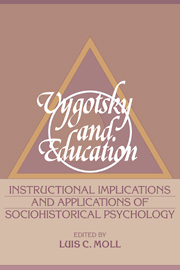Book contents
- Frontmatter
- Contents
- List of contributors
- Preface
- Acknowledgments
- Introduction
- Part I Historical and theoretical issues
- Part II Educational implications
- 7 Teaching mind in society: Teaching, schooling, and literate discourse
- 8 A Vygotskian interpretation of Reading Recovery
- 9 Vygotsky in a whole-language perspective
- 10 The development of scientific concepts and discourse
- Part III Instructional applications
- Name index
- Subject index
9 - Vygotsky in a whole-language perspective
Published online by Cambridge University Press: 05 June 2012
- Frontmatter
- Contents
- List of contributors
- Preface
- Acknowledgments
- Introduction
- Part I Historical and theoretical issues
- Part II Educational implications
- 7 Teaching mind in society: Teaching, schooling, and literate discourse
- 8 A Vygotskian interpretation of Reading Recovery
- 9 Vygotsky in a whole-language perspective
- 10 The development of scientific concepts and discourse
- Part III Instructional applications
- Name index
- Subject index
Summary
The best method [for teaching reading and writing] is one in which children do not learn to read and write but in which both these skills are found in play situations. … In the same way as children learn to speak, they should be able to learn to read and write.
(Vygotsky, 1978, p. 118)In this passage, Vygotsky expresses his belief that written language develops, as speech does, in the context of its use. It indicates his holistic inclinations and his awareness of the need for learners to be immersed in language for literacy learning to be easy.
Such a view is the essence of whole language. Whole language is more than anything else a philosophy of education. It draws heavily on Vygotsky, among others. As we relate the developing conceptualizations of whole language to the work of Vygotsky, we will explore (1) what whole language is; (2) what it takes from Vygotsky; (3) how whole language can contribute to the application and development of Vygotskian psychology; and (4) how it departs from or goes beyond Vygotsky.
What is whole language?
Whole language is a holistic, dynamic, grass-roots movement among teachers. It is spreading rapidly in the English-speaking countries of the world and moving beyond to other countries.
- Type
- Chapter
- Information
- Vygotsky and EducationInstructional Implications and Applications of Sociohistorical Psychology, pp. 223 - 250Publisher: Cambridge University PressPrint publication year: 1990
- 45
- Cited by



